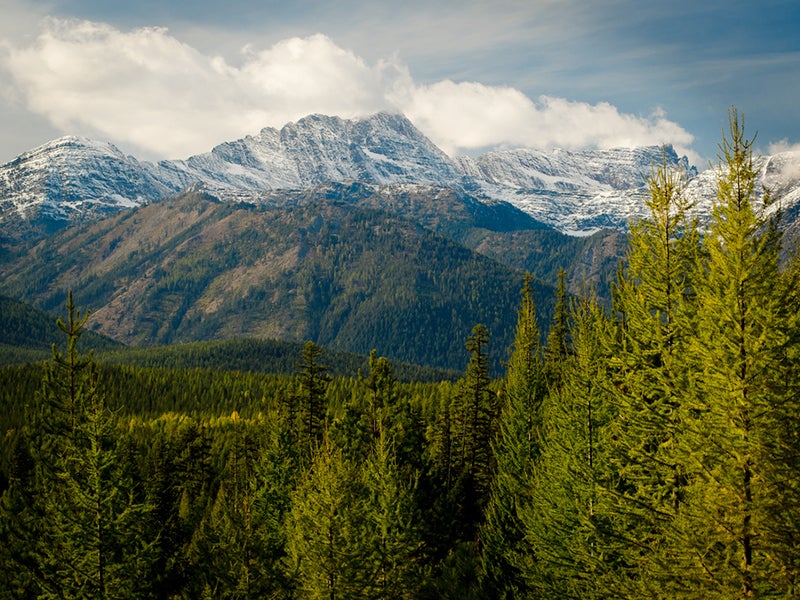Feds Approve Copper and Silver Mine in Montana’s Cherished Wilderness
The U.S. Forest Service recently approved the Montanore copper and silver mine. The project would involve blasting tunnels and removing 120 million tons of ore beneath the Cabinet Mountains Wilderness.

This page was published 9 years ago. Find the latest on Earthjustice’s work.
The Cabinet Mountains Wilderness in northwest Montana, which has received a high level of conservation protection since the 1930s, is facing an imminent threat. The Montanore copper and silver mine project would require blasting miles of tunnels beneath this expanse of glaciated peaks, transforming the pristine landscape into a large-scale industrial mining site. Despite scientific evidence that the mine will degrade streams and cause harm to endangered species in the wilderness area, the U.S. Forest Service just gave the green light to the project.
The impact of the Montanore Mine on vital creeks and streams, as well as wildlife, threatens to be irreversible. The Cabinet Mountains Wilderness is home to some of Montana’s most precious clean waters. In the final environmental impact statement, the mining company’s own consultants predict the mine will diminish flows in the overlying wilderness rivers and streams for 1,200 to 1,300 years. Threatening the water that flows through the Cabinet Mountains Wilderness—which is legally protected for its “outstanding resource waters” under the Clean Water Act and Montana law—will have a ripple effect on the surrounding ecosystem.
Granite Falls are one of the Cabinet Mountains Wilderness’ beautiful bodies of pristine water.
“Granite Falls” by Troy Smith/CC BY-NC-ND 2.0
“The Forest Service’s own analysis shows that the Montanore Mine will make sections of wilderness streams run dry, degrading the Cabinet Mountains Wilderness for centuries, “says Earthjustice attorney Katherine O’Brien. “These are irreplaceable streams—some of the purest waters in the United States—and Montana law requires that they be preserved intact for future generations and wilderness-dependent wildlife. The Forest Service defied that mandate and the evidence in giving the Montanore Mine the green light.”
Water pollution from the mine also threatens to wipe out vital populations of endangered bull trout. The process of extracting silver and copper will pollute the streams that support some of the last viable populations of migratory bull trout in the region. Logging, mining and construction of dams and roads have already damaged bull trout habitat across the species’ range, making strongholds of high-quality habitat like the Cabinet Mountains Wilderness essential to the survival of the species.
The wilderness is also one of the last remaining strongholds for grizzly bears in the continental United States, which is why the federal government and the state of Montana have initiated a project to increase the bear population there. Together with the neighboring Yaak River drainage, the Cabinet Mountains form one of six grizzly bear recovery areas designated by the U.S. Fish and Wildlife Service as essential to the species’ recovery.
As of 2014, the grizzly bear population in the Cabinet Mountains was just 21 individuals, a number so precariously small that there’s a real risk grizzlies will be wiped out in that range. Indeed, federal scientists believe that a program of “augmenting” the population by trucking in grizzlies from other parts of the Northern Rockies is the only reason the species can still be found in the Cabinet Mountains.
A lone grizzly bear in Montana.
John Pitcher/iStock
“Grizzly bears and bull trout are an integral part of Montana’s wild places and mountain streams,” says Mary Costello of Save Our Cabinets, a local non-profit organization. “The Montanore Mine would spoil the habitat in the Cabinet Mountains for these species and ruin the enjoyment of countless people who treasure Montana’s native fish and wildlife.”
The mine project, planned by Mines Management Inc., will disturb more than 1,500 acres in the Kootenai National Forest adjacent to the Cabinet Mountain Wilderness, removing up to 20,000 tons of copper and silver every single day for up to 20 years—nevertheless, neither state nor federal agencies have rejected the mine. Although the Montana Department of Environmental Quality determined that the mine would illegally degrade streams in the wilderness, it approved the first phase of the project, allowing the mining company a second chance to come up with a new report. While the U.S. Fish and Wildlife Service found that the mine would cause substantial and irreparable damage to endangered species and their habitats, it went ahead and released a biological opinion in favor of the mine.
“Every analysis of the Montanore Mine has shown that it will inflict irreversible damage on the Cabinet Mountains, one of the last remaining refuges for threatened bull trout and grizzly bears in our region,” says O’Brien. “Our state and federal agencies’ disregard of that evidence and insistence on pushing through the mine approval, whatever the cost, is irresponsible and unlawful.”
The Fish and Wildlife Service’s decision, which discounted the agency’s own scientific evidence, paved the way for the recent federal approval of the mine project. Earthjustice took the Fish and Wildlife Service to court in July 2015, invoking the protections of the Endangered Species Act in order to halt the Montanore Mine. Representing Save Our Cabinets, Earthworks and Defenders of Wildlife, we filed suit in federal district court in Montana to overturn the Fish and Wildlife Service’s conclusion that the Montanore Mine wouldn’t endanger the survival or recovery of grizzly bears or bull trout. Earthjustice attorneys are preparing to file briefs in the case this summer.
If we are going to fulfill the promise of protection offered by the Endangered Species Act and save the few intact wild ecosystems remaining in our country, we can’t let our last, best places for threatened species wind up on the rubble pile.
Established in 1993, Earthjustice's Northern Rockies Office, located in Bozeman, Mont., protects the region's irreplaceable natural resources by safeguarding sensitive wildlife species and their habitats and challenging harmful coal and industrial gas developments.